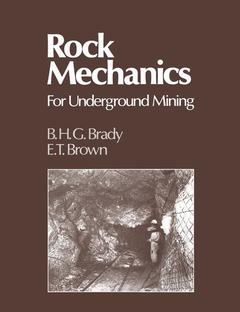Rock Mechanics, Softcover reprint of the original 1st ed. 1985 For Underground Mining
Langue : Anglais
Auteur : Brady B. H. G.

Rock mechanics is a field of applied science which has become recognised as a coherent engineering discipline within the last two decades. It consists of a body of knowledge of the mechanical properties of rock, various techniques for the analysis of rock stress under some imposed perturbation, a set of established principles expressing rock mass response to load, and a logical methodology for applying these notions and techniques to real physical prob lems. Some of the areas where application of rock mechanics concepts have been demonstrated to be of industrial value include surface and subsurface construction, mining and other methods of mineral recovery, geothermal energy recovery and subsurface hazardous waste isolation. In many cases, the pressures of industrial demand for rigour and precision in project or process design have led to rapid evolution of the engineering discipline, and general improvement in its basis in both the geosciences and engineering mechanics. An intellectual commitment in some outstanding research centres to the proper development of rock mechanics has now resulted in a capacity for engineering design in rock not conceivable two decades ago. Mining engineering is an obvious candidate for application of rock mechanics principles in the design of excavations generated by mineral extrac tion. A primary concern in mining operations, either on surface or underground, is loosely termed 'ground control', i. e.
1 Rock mechanics and mining engineering.- 2 Stress and infinitesimal strain.- 3 Rock mass structure.- 4 Rock strength and deformability.- 5 Pre-mining state of stress.- 6 Methods of stress analysis.- 7 Excavation design in massive elastic rock.- 8 Excavation design in stratified rock.- 9 Excavation design in jointed rock.- 10 Energy changes accompanying underground mining.- 11 Rock support and reinforcement.- 12 Mining methods and method selection.- 13 Naturally supported mining methods.- 14 Artificially supported mining methods.- 15 Longwall and caving mining methods.- 16 Mining-induced surface subsidence.- 17 Blasting mechanics.- 18 Monitoring rock mass performance.- Appendix 1 Basic constructions using the hemispherical projection.- A1.1 Projection of a line.- A1.2 Projection of the great circle and pole to a plane.- A1.3 Determination of the line of intersection of two planes.- A1.4 Determination of the angle between two lines in a plane.- A1.5 Determination of dip direction and true dip.- A1.6 Rotation about an inclined axis.- Appendix 2 Stresses and displacements induced by point and infinite line loads in an infinite, isotropic, elastic continuum.- A2.1 A point load (the Kelvin equations).- A2.2 An infinite line load.- Appendix 3 Calculation sequences for rock-support interaction analysis.- A3.1 Scope.- A3.2 Required support line calculations.- A3.3 Available support line calculations.- Appendix 4 Limiting equilibrium analysis of progressive hangingwall caving.- A4.1 Derivation of equations.- A4.2 Calculation sequence.- Answers to problems.- References.
Date de parution : 03-2012
Ouvrage de 528 p.
18.9x24.6 cm
Mots-clés :
evolution; geomechanics; geosciences; mechanics; rock mechanics; science
© 2024 LAVOISIER S.A.S.



